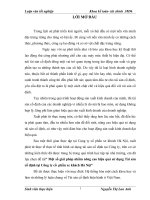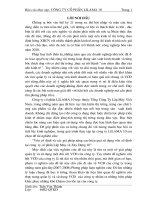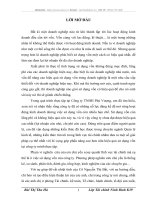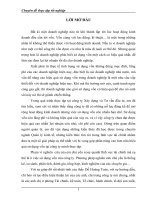MỘT số GIẢI PHÁP NHẰM NÂNG CAO HIỆU QUẢ ỨNG DỤNG SCM tại CÔNG TY LD dược PHẨM SANOFI AVENTIS VIỆT NAM e
Bạn đang xem bản rút gọn của tài liệu. Xem và tải ngay bản đầy đủ của tài liệu tại đây (62.22 KB, 11 trang )
MỘT SỐ GIẢI PHÁP NHẰM NÂNG CAO HIỆU QUẢ ỨNG DỤNG SCM
TẠI CÔNG TY LD DƯỢC PHẨM SANOFI-AVENTIS VIỆT NAM SOME
SOLUTIONS TO IMPROVE SCM APPLICATION EFFECTIVENESS IN
SANOFI-AVENTIS PHARMACEUTICAL JOINT VENTURE COMPANY
1
Overview on pharmacy of Vietnam
Before the liberation, Vietnam's pharmaceutical industry was hardly developed, the
medicines were mainly imported from abroad. After the liberation, with the help of
finance and technology of SEV, Vietnam's pharmaceutical industry was formed,
mainly in Hanoi and Ho Chi Minh. In 1996, the Prime Minister promulgated the
"National Drug Policy," Vietnam's pharmaceutical industry began to prosper and
have made remarkable progress. According to the Vietnam Drug Administration’s
data, within 10 years (1995-1005), total market value of pharmaceutical industry
increased 2.9 times from $280 million in 1995 to $810 million in 2005. Drug
consumption per capita increased 2.4 times from $4.2 in 1995 to nearly $10 in 2005,
increased 10 times compared to 1990.
Production of the domestic produced drugs increased from 2,280 billion VND,
equivalent to USD 152 million in 2000 to 6,300 billion VND, equivalent to USD
395 million in 2005 (accounting for over 48% pharmaceutical market), in which the
area with foreign investment capital, there are 30 investment projects, providing an
annual $40 million pharmaceutical products. Goals by 2010, drug produced in the
country satisfies 60% the needs of the market; drug consumption per capita is $1215/year, reaching 1.5 pharmacists/10.000 people.
51
100
80
60
Eas
40
20
2n
0
d
1s t Qt
Qtr r
t
3r
d
Qt
r
4t
h
Qt
r
We
st
Nor
th
2. Development orientation of pharmaceutical industry, post-WTO chances and
challenges
2.1 Development orientation of pharmaceutical industry.
Define the role of the pharmaceutical industry in the development of socio-economy
and security of the country, on 30/6/2006, the Prime Minister signed Decision no.
153/2006/QĐ-TTTg approving the master plan for development of Vietnam Health
System for 2006-2010 and Vision 2020, defining the goal of the pharmaceutical
industry in this period is :
•
Development of pharmaceutical industry to become a spearhead economic
sector
- Promote the potentiality, strength on medicine and traditional medicine.
By 2015, ensure 30% of domestically produced drugs are derived from medicinal
plants and traditional medicine
- Ensure the domestically produced drugs to meet 60% of pre-drug value in 2010,
and 70% in 2015.
- Construct and develop the circulation distribution and supply system of drugs from
the centre to locality, ensuring all people have the demands are able to access to
quality medicines and at reasonable prices.
- Goals by 2010, all drug production and business facilities must meet the Good
Practices (GPs), a set of rules to good medicine practice including rules.
2.2
Main changes on post-WTO trading environment of pharmacy
Officially to become the 150th member of WTO or that Vietnam officially joints
into the playing-field with the rules, general regulations in the world. In particular,
there are four basic principles:
-
Most favored Nation - MFN, accordingly, if a member gives another member
the preferential treatment, it must also give such preference to all other members.
However, this principle is not absolute in nature but there are exceptions and
exemptions.
-
National Treatment - NT: imported goods, foreign services and intellectual
property rights must be treated equally compared to domestic goods of the same
type. However, within the framework of WTO, NT only applies to goods, services
and intellectual property rights, rather than to individuals and legal entities.
-
Open the markets for goods, services and foreign investment, establishing a
system of publically global trade.
-
Fair competition: free competition in the same conditions.
The tax changes:
- Expected that applicable duty to pharmaceutical products is only 0-5% of tax
against 0-10% as before.
- Average tax is 2.5% after 5 years as from Vietnam enters into WTO.
- The average tax for cosmetics reduces from 44% to 17.9% at the time Vietnam has
to fulfill its commitments.
Change in business right:
- Since 1/1/2009, the enterprises with foreign investment capital and branches of the
foreign enterprise in Vietnam can directly import and export pharmaceutical
products.
- Foreign enterprises can not participate into directly distributing pharmaceutical
products in Vietnam. Drugs produced by foreign enterprises are sold to enterprise
specialized
in
distribution.
3. Opportunities and challenges for Vietnam's pharmaceutical enterprises
3.1. Opportunity
With the advantage of a multi-national company, Sanofi-Aventis has two strong
advantages in the pharmaceutical business including the ability of research and
development (R & D), and ability of capital. Also, with the network in most
countries worldwide, the company is able to access to many resources of
information on situation of diseases, as well as results of scientific researches
outside the company. Moreover, the company also owns a valuable asset that is
Sanofi-Aventis brand that has been confirmed on the domestic and global markets.
According to a ranking list of the world's pharmaceutical companies, Sanofi-Aventis
is currently the third pharmaceutical company in the world and the top one in
Europe, this is an undeniable advantage, enabling the company to launch new
products to the market.
In the context that Vietnam's pharmaceutical industry is a young industry, with a
high growth rate, the demand on drugs for treatment of the people is increasing
(refer to data on drug consumption per capita in Vietnam), which promises an
extremely potential pharmaceutical market.
The integration to WTO has prompted Vietnam to rapidly improve its legal system,
At present, we have 5 sets of important laws to regulate business activities in the
pharmaceutical industry that are: Pharmacy Law and Commercial Law and
Enterprise Law, Law on Intellectual Property, Law on Investment and Competition.
This helps the general business environment and business environment in the
pharmaceutical industry more obvious and patent, enabling enterprises in planning
long-term business strategy and development plans .
Currently, the company faces an extremely problematic issue that is counterfeit,
fake, poor quality goods ..., the problems are causing serious losses to the company
both prestige and sales. On the market of Vietnam nowadays, there more than 10
products of the company are counterfeited and its brand is imitated by domestic
companies, including many products being copied many times as Nautamine,
Theralene ...
In addition, there are some items not yet expired license had been launched
by the company for mass production as Plavix ... These are matters beyond the
control of the company, so with the introduction of intellectual property law,
hoping that the company can solve this problem thoroughly and efficiently.
Joining the WTO also sets out the requirements for reductions in tariffs and
import fees, which will help enterprises reduce business costs, and this is also an
opportunity to help enterprises be able to access more customers.
3.3.2
Challenges
General Director
Finance
and
Administr
ation
Marketing
and
Sales
Regist
ration
office
SCM Incharge
Manageme
nt of
suppliers
Goods purchase
Order
management
Order
performance
Production
Figure 2: Recommendation for new organization model in Sanofi-Aventis
52
Figure 2: Recommendation for new organization model in Sanofi-Aventis
Through this model, we see that this organization is leaner than the older
model, unifying the operations and supply chain functions within a department,
this will help the chain can afford and scope to perform the task on all three areas
is management of supplier, management of internal operations and management
of customers. This method will help the chain better understand the customer's
needs, quickly grasp the changes in supply capacity to be able to make timely
adjustments internally, to avoid gaps in communication news, and more favorable
implementation strategies and activities of the company's supply chain.
4.2
Building up overall operating strategies
Building up business strategies, or competitive strategies in order to
determine the operation direction is extremely necessary to keep the enterprise to
the correct direction, and ensuring the coordination of activities most effectively,
however, this is one of the weaknesses of the company today. The way that the
company are using at present is based on business results last year to set goals for
next year's sales, then sales target will be allocated according to each item and
charger of the label who will make own plans to achieve the above objectives.
About the company, the Company will support in form of discounts, sales bonus
and invest a part of budget in marketing activities such as promoting products,
materials for the promotion... For the other departments, the company does not
have any specific operational strategy to mutually carry out operation.
We know that competitive strategy begins by identifying customer needs,
based on which will set out how to satisfy those needs with its products and
services. A good competitive strategy is a strategy that can maximize the
effectiveness of the value chain in the enterprise, starting from the development
of new products, marketing / sales, production, distribution and service, etc.
Implementation of competitive strategy requires the involvement and
coordination of departments in the value chain, for example, product
development strategy is to identify new orientation for which is in development
for products in the future; marketing and sales strategy identifies market
segments, how to position the products, pricing and sales policies and strategies
on supply chain determine how to buy, transport, inventory, distribution,
customer services, etc.
The success of the business depends on two conditions: first, the competitive
strategy and functional strategies must fit together to form an overall corporate
strategy, each one must be able to support other functions, and help enterprises to
achieve competitive goals; secondly, the activities of functional departments must be
in accordance with the available resources, to ensure that every department can
implement proposed strategies.
Operations of the business will not be effective if strategies are not uniform, or
resources can not support strategies, for example: marking the program of delivery
to the customer hands within 24 hours, while the distribution department wants to
reduce transportation costs and tends to collect all orders assigned to delivery goods
at the same time, this conflicts with the marketing activities ...
To develop a uniform strategy, it is important to identify needs of customers in every
market segment that the business is trying to target, and consider problems of supply
chain in satisfying this demand. Understanding customer needs is the first request to
determine requirements for service and costs properly, and find out the unusual
factors to help the businesses identify situations that may occur deal with them.
4.3
Market segment of pharmacy
We know that the first point in building a competitive strategy is a market segment
or customer classification which is one of the conditions for solutions to uniformity
of operational strategy .
As mentioned earlier, currently the company has three main objects of customers:
resellers, importers and pharmacies. Objects have a range of different activities, so
they are unable to compete against each other. On the other hand, few agents and
importers and long-term contracts lead to few problems, so pharmacies are
considered main customers of the company. Therefore, in this section, we mention
only pharmacies.
We know that different customers have demand different on the following aspects:
• Number of orders
• Delivery time
• The required commodity
• Requirements of service levels
• Prices
Since the level of service is closely related to cost, high service will increase cost of
both time and money, whereas low service will lose customers and may lose
business opportunities, so it is important to define service policies for different
customers appropriately.
For those reasons, the company should classify pharmacies into three categories I, II
and III based on the size and potential of the drug. For every class of customer, a
separate policy on discount terms, service levels, delivery times and sales
policies ...will be applied. This, on one hand helps the company reduce and
rationalize costs, on the other hand encourage pharmacies to enjoy the higher level
of service. However, because the company wants to target at as many customers as
possible, a solid foundation in the market, the customer classification should focus
more on classification of services rather than the discount rate, to avoid too many
differences between regular customers and irregular customers.
5. Recommendations
Through practical activities and assessment of individuals, to improve the
performance of business in general and supply chain in particular, I have two
recommendations as follows:
5.1
Develop of "open" management system
Sanofi-Aventis Vietnam is one of enterprises with large scale in Vietnam; employees
have a high degree of qualification; all tasks are described with the detailed
implementation process, leading to high productivity, and ensuring implementation
of the work as required. However, since business conditions and regulatory
environment are always changing, while the regulations and processes have not
been changed and updated frequently, organization of the work is done mainly by
routines, path, losing activeness, creativeness and lack of flexibility in handling the
job.
For effectiveness of SCM, it is essential to organize the business towards promoting
activeness, creativeness and sense of responsibility of all members towards the
common goal of the entire enterprise. Therefore, it is necessary to build quality
monitoring division, in charge of reviewing the process and receiving comments or
complaints from customers and internal departments in order to implement reform
of functional departments across the enterprise. This division shall receive and
propose plans for continuous and comprehensive improvement of the system, and
evaluate and inspect internally to detect threats and deviations in the operation of the
organization for timely correction.
5.2
Modernization of production and improvement of staff
The labor structure of the company shows that the company still has too many
unskilled workers due to obsolete equipments. With the trend of industrialization
and modernization today, I think the company should invest more in machinery and
technology, modernize production processes, reduce unskilled labor and improve
product quality. In addition, the company should develop self-training policies to
improve skills and qualifications of employees in the company, and qualified staffs
that are ready to adapt to new business conditions of the company.
CONCLUSION:
By analyzing post- WTO conditions, opportunities and challenges of the
pharmaceutical industry in Vietnam in general and Sanofi-Aventis in particular, the
thesis provided some measures and proposals to improve the efficiency of SCM in
Sanofi-Aventis company including reorganization of corporate structure; planning
the overall competitive strategies, development of strategy for departments;
customer segmentation; development of open management mechanism and
modernization of production, improvement of staff’s qualification. With solutions
and recommendations stated above, I hope that the company may consider and
apply them to build a better organizational structure, reduce costs and bring more
benefits to the customers and patients in Vietnam.









